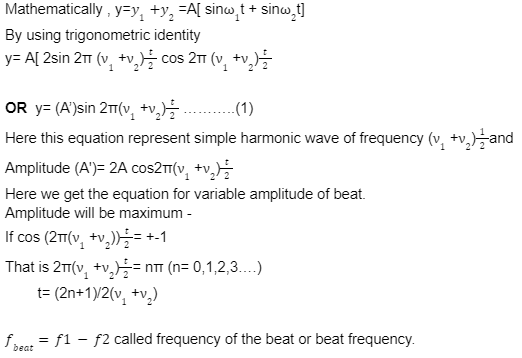When we hear any music or sound from two sources, sometimes we are able to differentiate them and sometimes we hear a new sound. This phenomenon also we heard before in the interference topic. So what is beats then ?
when two waves of nearly the same frequency and amplitude and travelling along the same line are sounded together. That resultening sound cantain maximas and minimas. This phenomenon is called ‘Beats’.This type of similar phenomenon we also heard in the standing wave topic.
One rise and one fall in the intensity of sound constitutes one beat.
Body
As we discussed earlier for the formation of beats the two waves have nearly equal frequency and equal magnitude. When a beat is formed we hear a variable intensity sound, it’s due to the change in amplitude of the resultant wave. Let us discuss more on this.
Consider two waves of same amplitude A and slightly different frequencies v1 and v2 .These waves are represented as –
y1= Asin 1 t = Asin 2π1 t …………(1)
y2= Asin 2t= Asin 2π2t…………..(2)
Where 1>2
By the principle of superposition resultant displacement is the sum of two individual individual displacements

Terminology of Beats
- waxing- The maximum value of the amplitude of the beat is called waxing
- waning- The minimum value of the amplitude of the producing beat is called waning.
- Periods of Beats- As we discussed above, there is a maximum called waxing and minimum called waning. So the time interval between two consecutive waxing or conjugative waning is called bats period.
- Frequency of Beats- The number of beats heard per second is called the frequency of beats.
Beats vibration- Beats vibration are caused by vibration that is very close to the same period and same amplitudes.The amplitude must at least be similar to produce a beat. otherwise ,the dominant amplitude will be only slightly affected by much lower amplitude and effect will not be felt.
Condition for the formation of Beats
The sensation of hearing of any sound remains in our brain for 0.1 second.so we can distinguish between two sounds if time intervals between is more than 0.1 seconds or frequency difference between two waves is less than 10 Hz( v= 1/T= 1/0.1= 10 Hz)
But if the frequency difference between two waves is more than 10 Hz then it becomes difficult to distinguish between rise and fall in the intensity of sound .Hence Beats can not be heard.
Phenomenon of Beats
The physical effect of the superposition of two or more waves is called interference.The phenomenon of Beats is an example of interference in time because in this case ,we consider the variation in the intensity of sound with time at a given place
Application of Beats
Turning of musical instruments
Musicians use the phenomenon of beat in turning various instruments.When an instrument is tuned against a standard frequency and till the beat has not disappeared it is tuned , then the instrument is in a tune with that standard frequency. –
Other applications are – used in experiments regarding sonometers, in different radder systems, in mining to determine harmful gases, etc.
Difference between Standing wave and Beats
As we discuss the beats, we can notice that there are many similarities with standing waves. Like both cases the magnitudes are variable and both are the phenomenon of interference of the wave. But in case of the standing waves, waves travel in opposite directions but in case of beats waves travel in the same direction. In standing waves the frequency of both waves are equal but in beats frequencies are slightly different in magnitude.
Conclusion
Beat is one of the important phenomena of waves generally produced in case of sound waves. There are many practical applications of beats in science and engineering.The important criteria for beat formulation is same amplitude and slightly different frequency. It has many applications in the Doppler effect also.
 Profile
Profile Settings
Settings Refer your friends
Refer your friends Sign out
Sign out






